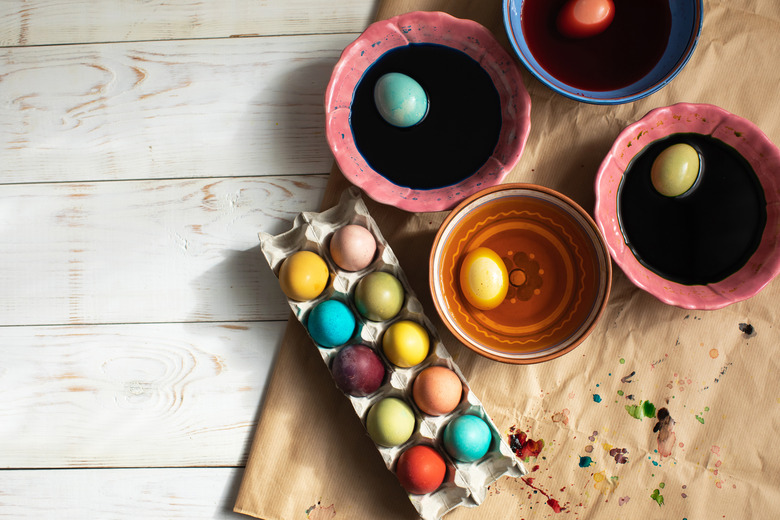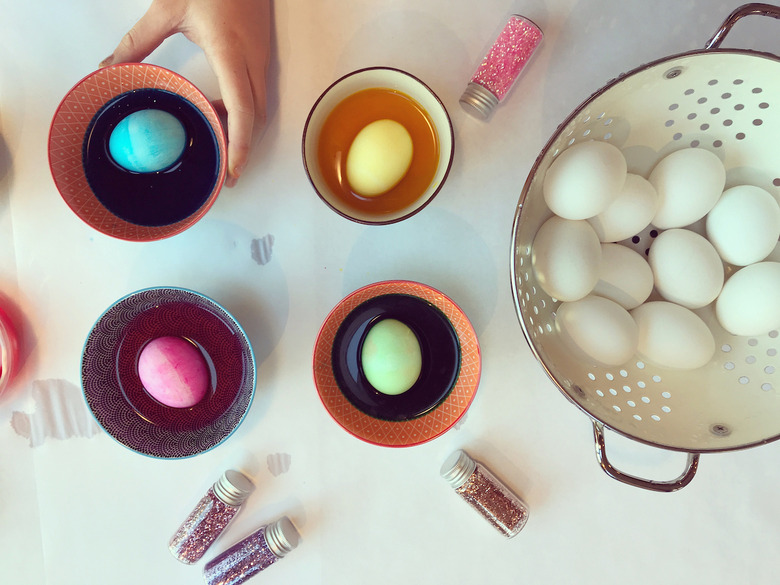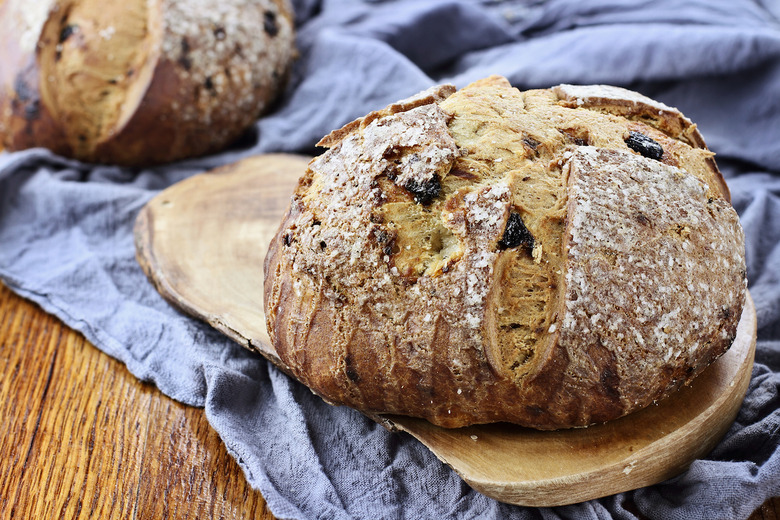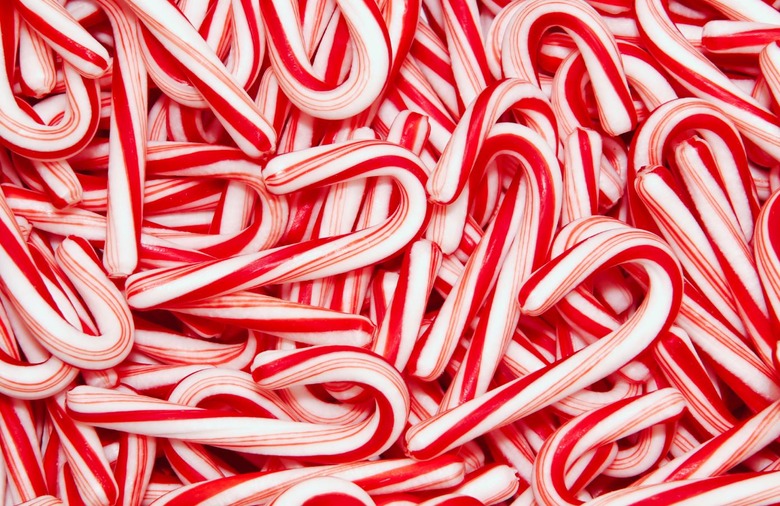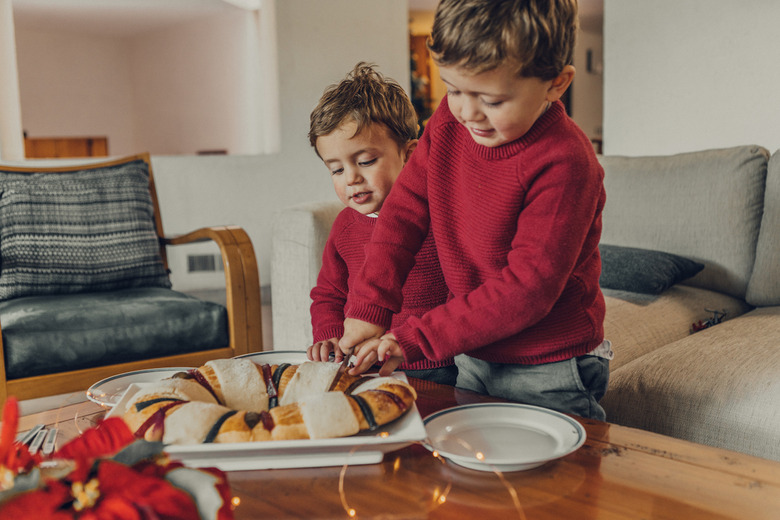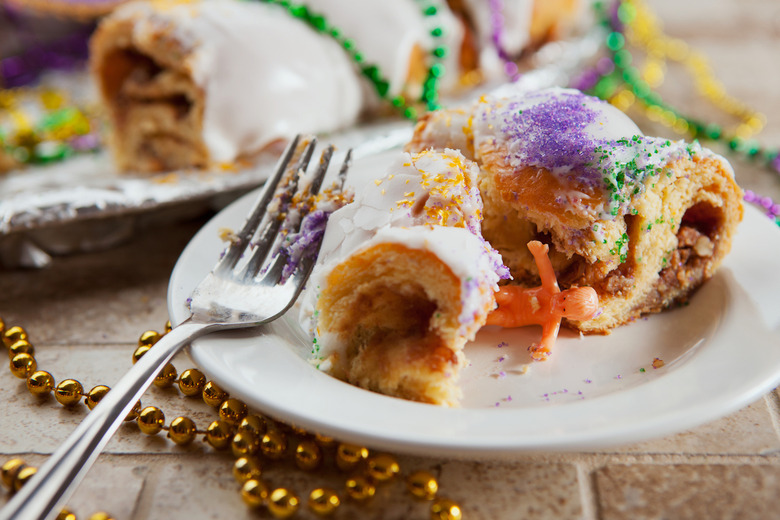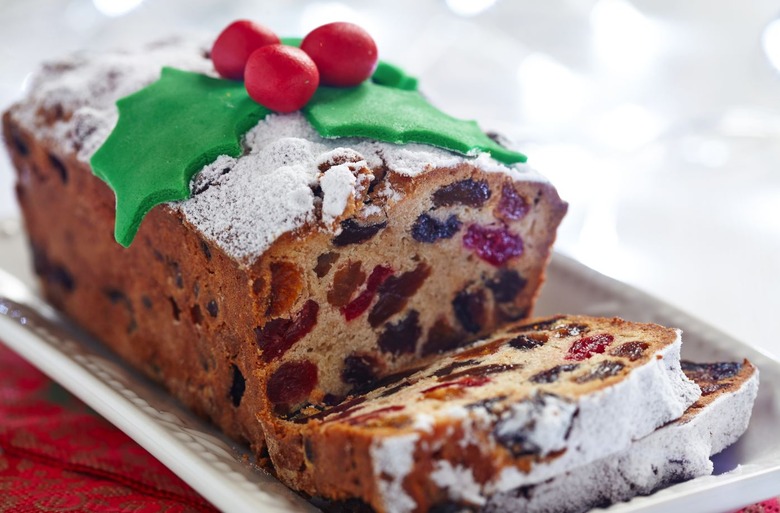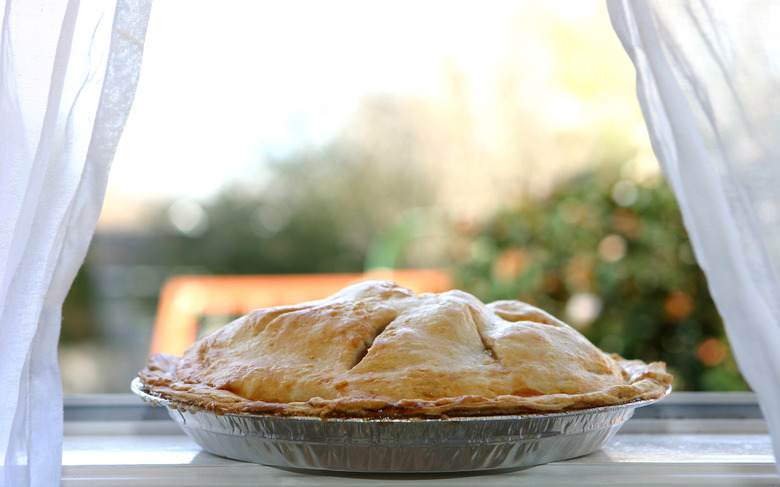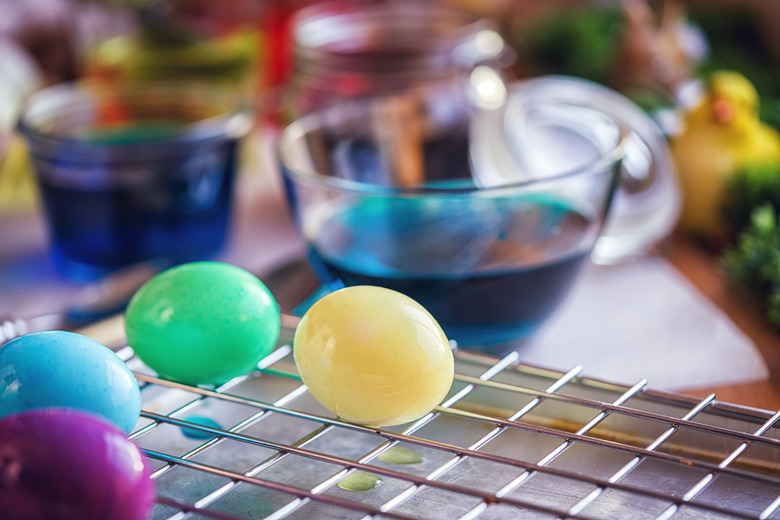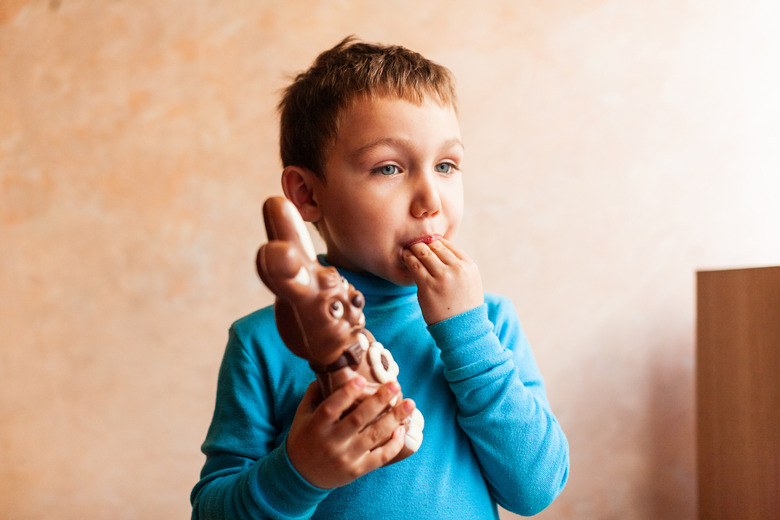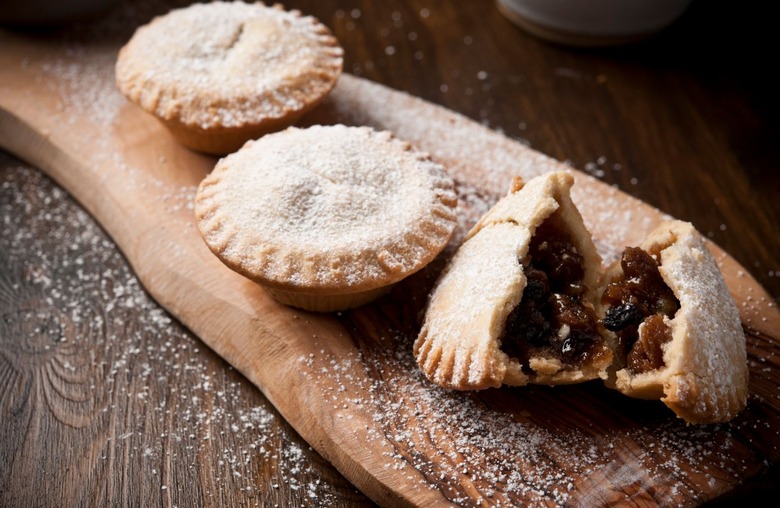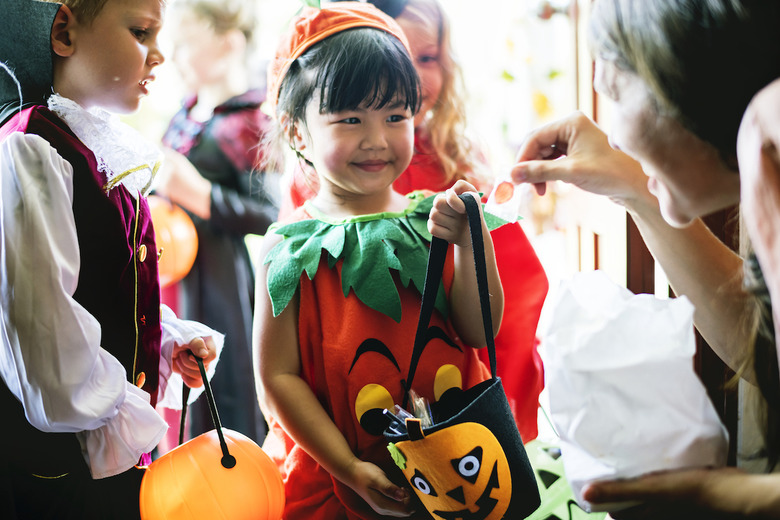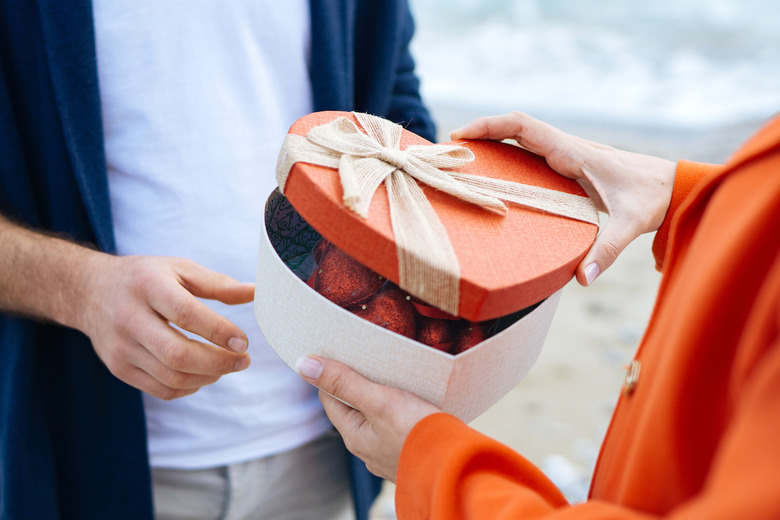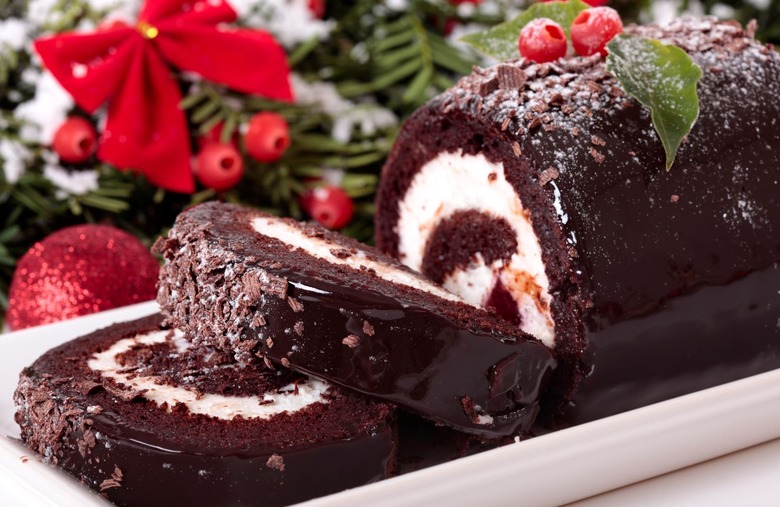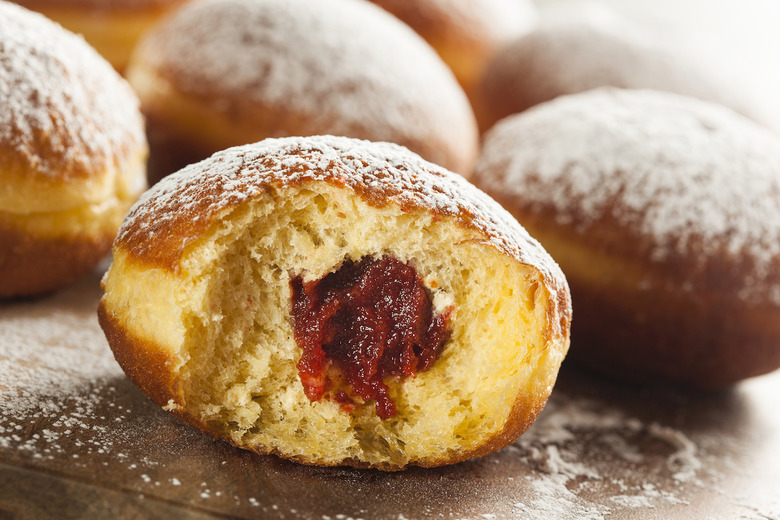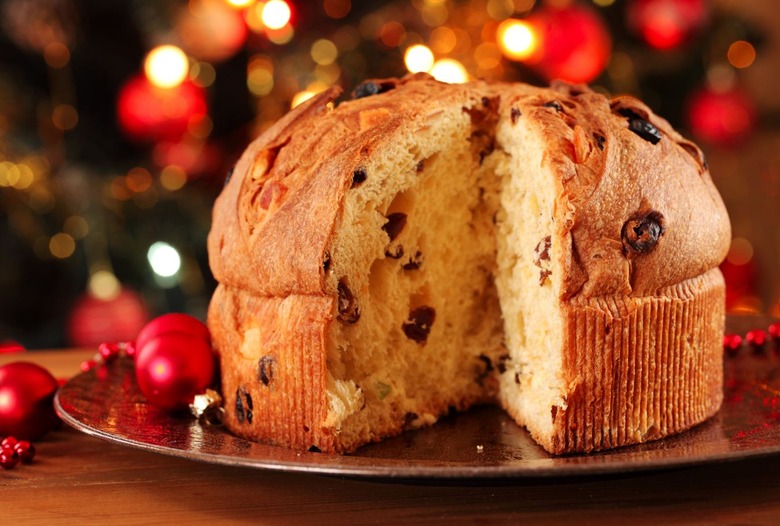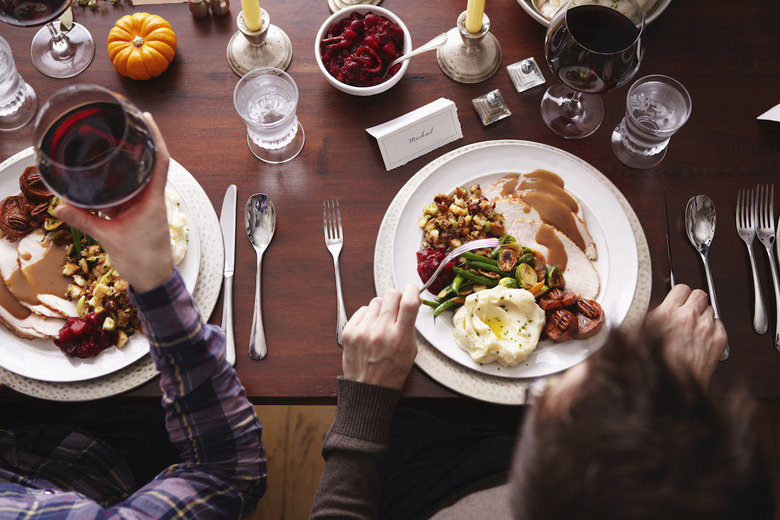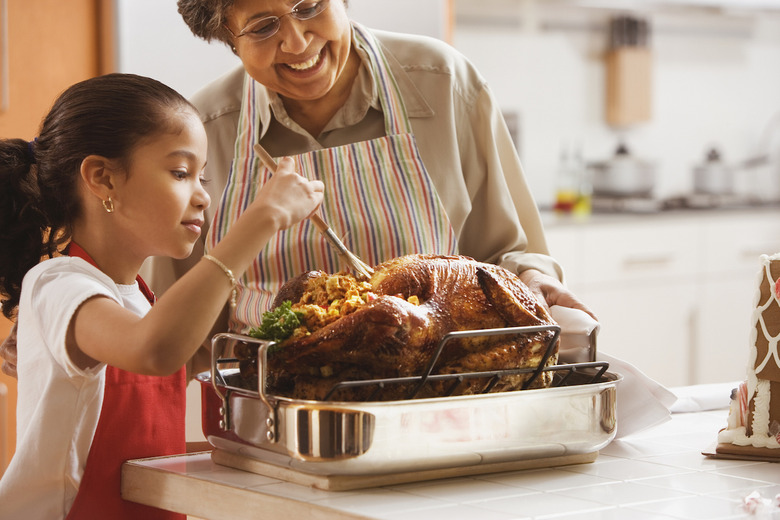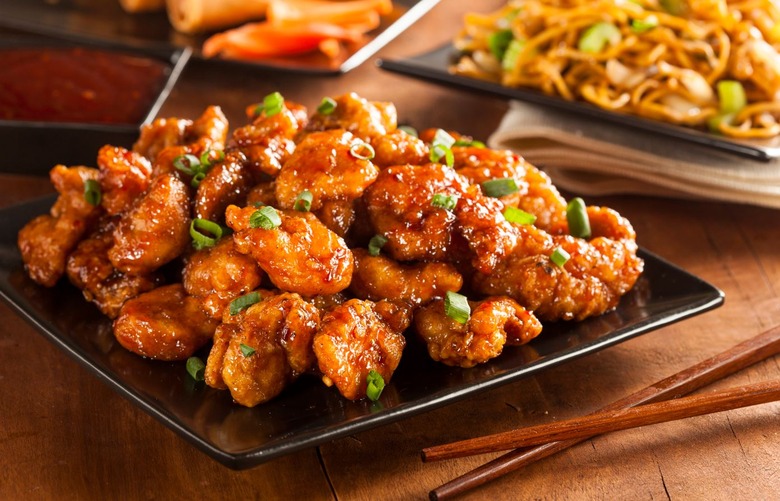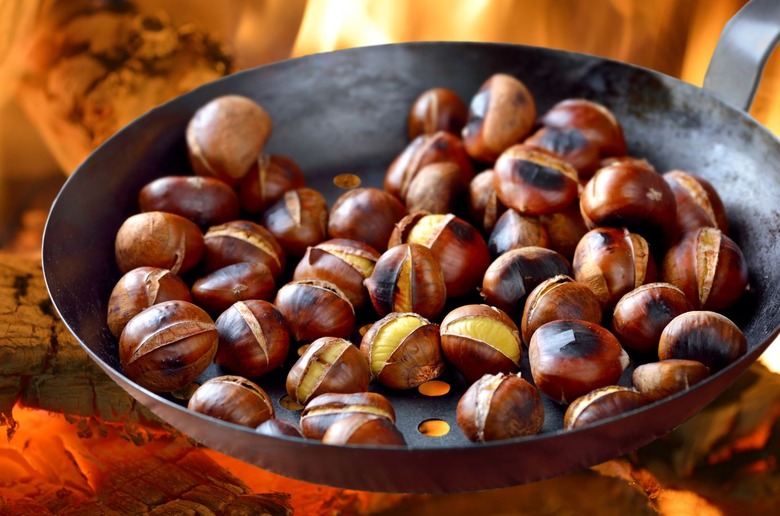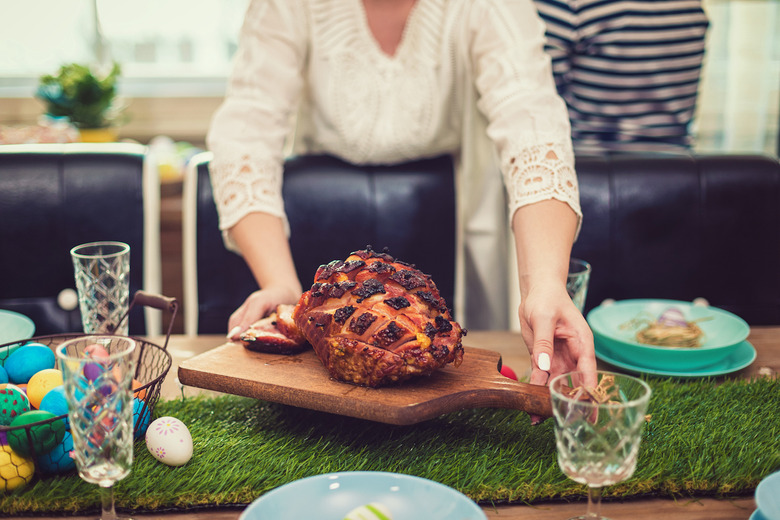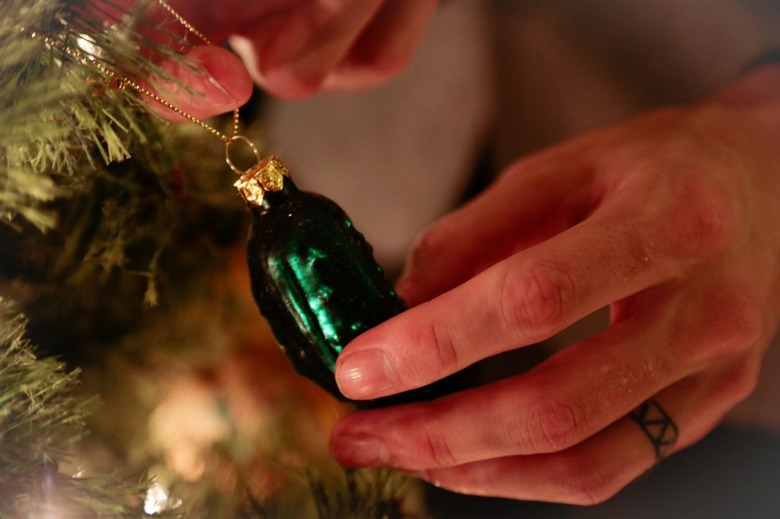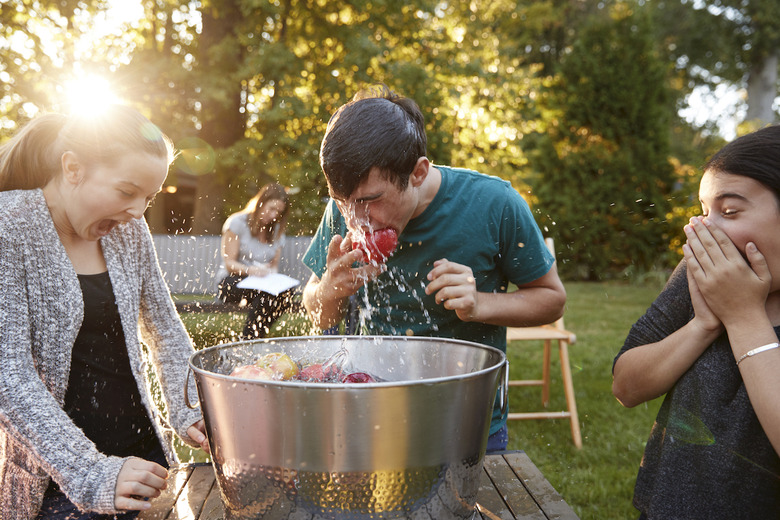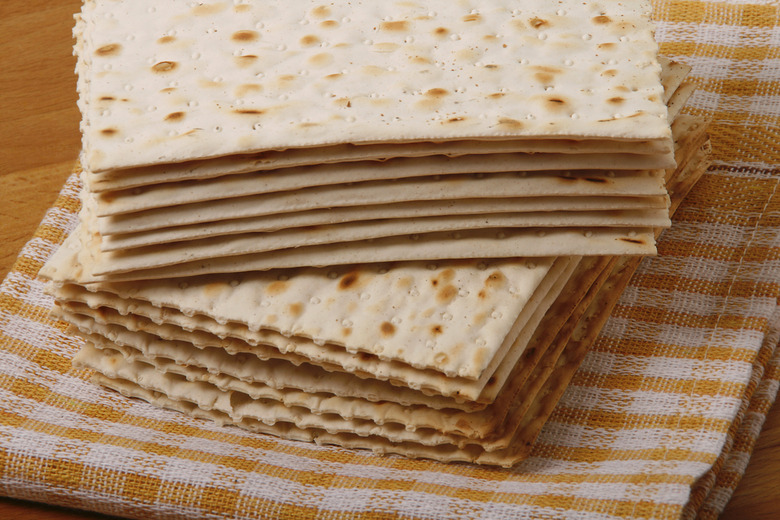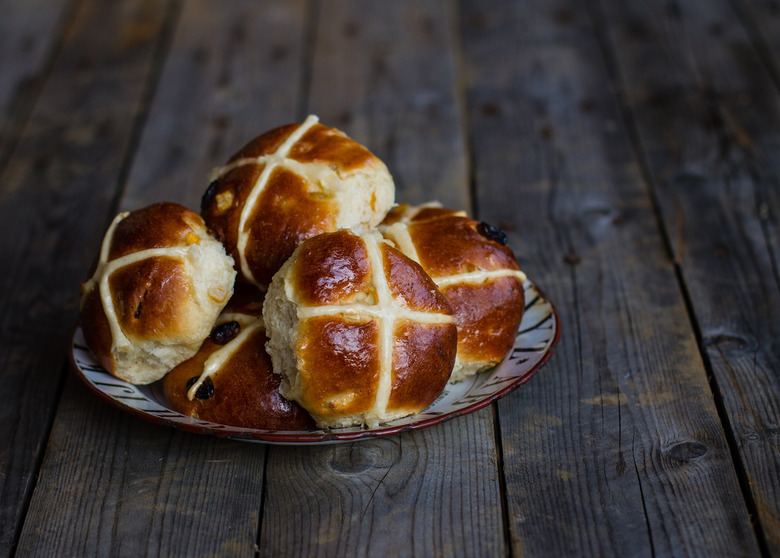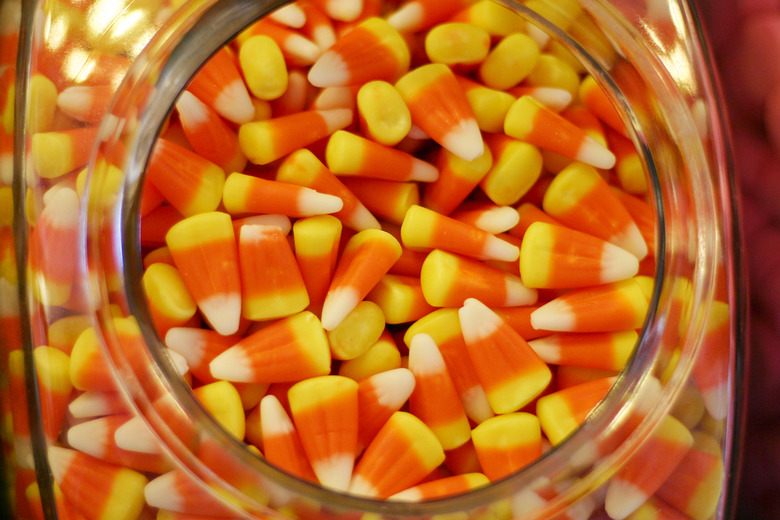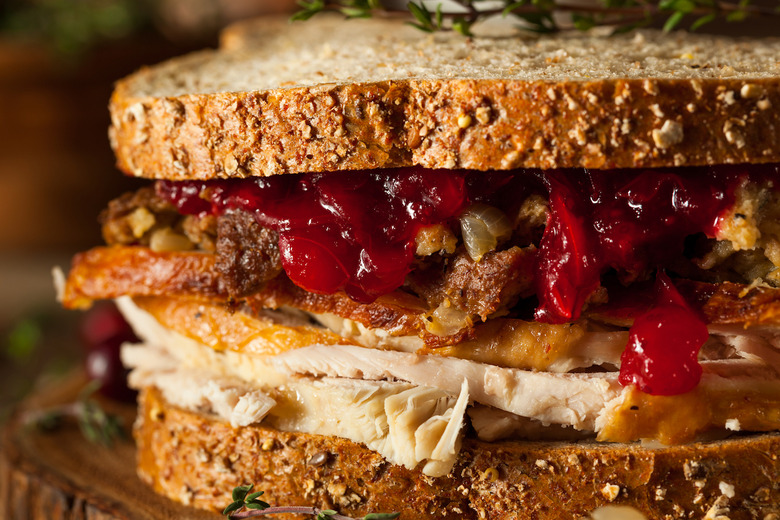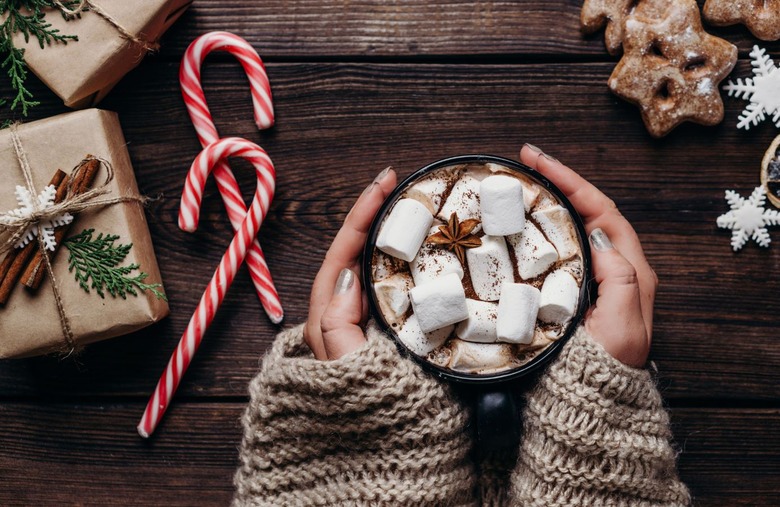Why Do We Dye Easter Eggs? And Other Holiday Food Mysteries, Solved
No matter what you celebrate or whom you celebrate with, food and holidays go hand and hand. Good times only get better when good food gets involved. At the next holiday party, impress the other guests and demystify these 40 holiday food mysteries.
Can you eat dyed Easter eggs?
Unless you're in the market for a foodborne illness, you should skip on cracking that colorful Easter egg shell. According to the USDA, all cooked eggs, including hard-boiled eggs, must be consumed immediately after cooking. After sitting out for two hours, eggs may grow harmful bacteria. Always opt for fresh eggs whether making the best scrambled eggs or experimenting with surprising ingredients that go great with eggs.
Why is eating KFC on Christmas so popular in Japan?
You might not have known it before now, but in Japan, visiting KFC on Christmas is a huge deal. According to the BBC, an estimated 3.6 million Japanese people dine at KFC during the Christmas season (a tenfold uptick from the rest of the year), special Christmas dinners need to be ordered weeks in advance and on Christmas Day, KFCs have lines out the door. The reason that this has become a Christmas tradition there? Marketing. In 1970, Takeshi Okawara, who'd recently opened the country's first KFC, decided to sell a "party barrel" on Christmas in order to drum up business. It proved to be so popular that in 1974, the idea went national, and the rest is history.
Why nian gao during Chinese New Year?
Also known as "rice cake" or "New Year cake," nian gao are delectable wishes for a successful new year. The latter part of the dish's name, "gao," translates to tall or high, referring to a new year higher and better than ever before. The cakes of sticky rice date back more than 1,500 years and have evolved into several regional variations. Southern Chinese nian gao are stir-fried and savory. In Inner Mongolia and the northern province of Shanxi, nian gao are deep-fried and filled with red bean paste and mashed jujube. Beijing nian gao incorporates jujube too, opting instead for a red dot at the center of the flower-molded cake.
Is Irish soda bread even Irish?
This dense bread made of flour, buttermilk, salt and bread soda, more commonly known as baking soda, allowed for a relatively inexpensive way to bake bread without an oven. Soon, regional and luxurious variations, including those with caraway seeds or raisins, cropped up across Ireland and America. Today, the Society for the Preservation of Irish Soda Bread dedicates itself to maintaining traditional Irish soda bread recipes sans ingredients other than flour, buttermilk, salt and baking soda. While Irish soda bread is Irish, there are other seemingly non-American dishes invented in the U.S.
Why are candy canes hook-shaped?
Candy canes, which nowadays come in plenty of flavors far crazier than peppermint, are the treat most synonymous with the holidays. But why are they hook-shaped? According to the National Confectioner's Association, back in 1670, the Cologne Cathedral choirmaster handed out sugar sticks to the young singers in order to keep them quiet during a long nativity ceremony. He bent them into the shape of a shepherd's crook to honor the occasion. So candy canes have been tied to Christmas literally since their invention, but they didn't gain their stripes and minty flavor until the 20th century.
What are sugarplums?
Visions of sugarplums may be dancing in children's heads, but what are they actually visualizing? If you think they're just a variety of plum, think again. Historically, sugarplums are actually a seed or nut surrounded by hardened sugar, similar to Jordan almonds. They're also the term for finely diced dried fruit mixed with nuts, honey and spices like fennel and anise, which are then shaped into a ball and rolled in sugar.
What’s with the candied fruit on the rosca de reyes?
A Three Kings Day tradition, rosca de reyes translates to "king's wreath." This crown-shaped sweet bread is topped with sugar and dried fruits and is referred to across the Mexican community simply as rosca. The candied fruit, in shades of green, red and white, signify the jewels on the crowns of the Magi, as well as the material elements that are overcome on one's spiritual journey. Bread bakers hide a small plastic baby figurine in the bread similar to those found in a king cake.
Speaking of which, why is there a plastic baby in the king cake?
Yes, king cake and rosca de reyes each contain a plastic baby hidden in the folds of sweet bread. As Three Kings Day and Epiphany dishes, both celebrate the arrival of the three kings to the manger of Jesus and have roots in 17th-century French Galette des Rois, large rounded cakes with a single bean hidden inside. Whoever pulled the slice of cake with the bean was dubbed king or queen for a day. Eventually, the French king cake tradition traveled to Spain then the Americas. Now an iconic Southern dish integral to the Mardi Gras tradition, king cake no longer contains a hidden bean but instead a more literal representation of the infant Jesus, a porcelain or plastic baby figurine.
Why are fruitcakes immortal?
Is that fruitcake in the back of the pantry from last year's Christmas, or from two years ago? It doesn't really matter, because these edible punchlines last more or less forever. The dryness of the ingredients and the traditional addition of alcohol both inhibit microbial growth and act as excellent preservatives.
What makes apple pie so American anyway?
An undoubtedly iconic pie, apple pie is not as American as the popular saying would suggest. Neither apples nor the first apple pie recipe originated in the U.S. Instead, the fruit is native to Asia and the first recipe was recorded in 14th-century England.
Why do we dye Easter eggs?
Eggs — dyed, hidden, hunted or cooked — are integral to Easter. In one of the earliest recorded instances of Easter egg decorating, King Edward I of England purchased 450 eggs to be colored and covered in gold leaf and distributed to his royal entourage on Easter 1290. Whether this custom originated with Christians or not is heavily debated. One theory holds that eggs produced by hens during the strict Lent season were hard-boiled and preserved for after the fast. The end of Lent and gifting of eggs fell right around Easter. Scholars also suggest that eggs were integral to a springtime Anglo-Saxon celebration of the goddess Eostre. Some of those pagan customs carried over to the Christian holiday.
What about Chocolate Bunnies?
Similar to the Easter eggs, bunnies were another pagan symbol of fertility seemingly adopted by Christians, this time German Christians. Eighteenth-century German immigrants settled in Pennsylvania and brought the Easter Bunny with them. Children crafted homemade nests for the rabbit to lay dyed eggs in. And while chocolate bunnies were not unheard of, they spread to the masses in 1890 thanks to Robert Strohecker, a Pennsylvania store owner who placed a 5-foot-tall chocolate bunny in his store's display window. In spite of this rich history, we rank hollow chocolate bunnies low among all Easter candy.
What is figgy pudding?
Now bring us some figgy pudding, but only after you explain to us what exactly it is, because it sounds rather odd. It uses the British definition of "pudding," meaning any dessert (be it actual pudding, cake, pie or other sweet) and is essentially a dense cake made with molasses, nuts, spices like cinnamon and nutmeg, and lots of finely chopped dried figs.
What is mincemeat?
Mince pie is a traditional British Christmas dessert, and the filling is traditionally called mincemeat. While in the past (its roots can be traced to the 13th century), it was traditionally a combination of finely minced meat (usually mutton) mixed with fruits and served as a main course, today just about every variation is meat-free. It's made with dried fruits and spices including clove, nutmeg and cinnamon, as well as brandy and served as dessert.
Why do we give out Halloween candy?
When Christianity spread to Celtic lands in the ninth century, the Celts were already annually celebrating Samhain, the one-night return of the dead to Earth. During Samhain, villagers dressed up as ghosts, demons and more. They exchanged trickster antics for food. The Christian All Souls Day celebration adopted some of these Celtic practices. Poorer folk would visit the homes of the rich and receive soul cakes in exchange for promised prayer. In Scotland and Ireland, this ritual turned to guising — the more sugary tradition we know today. The hodgepodge of Celtic, Scottish and Irish traditions arrived in America in the 19th century and exploded onto the national scene following the post-World War II baby boom. Today, Americans spend over $2.6 billion on their favorite Halloween candy.
What do the crops and corn near the Kwanzaa kinara represent?
Two of the seven Kwanzaa symbols are food-related. First, Mazao, the crops, call back to the first-fruits and harvest celebrations Kwanzaa was modeled after. Secondly, Muhindi, corn, represents the children. Both symbols are placed on the Mkeka or mat. The seven symbols are just one of many things everyone should know about Kwanzaa.
Is Valentine’s Day chocolate really an aphrodisiac?
The right answer to "what to buy on Valentine's Day?" is always chocolate. Don't question it. However, even the richest, most decadent morsel from the best of chocolate shops will not have the effect of a natural aphrodisiac. But dark chocolate can give the gift of a healthy heart.
And whose idea was it to put the chocolates in a heart?
English chocolatier Richard Cadbury, yes of that Cadbury chocolate fame, is believed to be the first to have produced heart-shaped chocolate boxes. Prior to his stroke of genius, Cadbury had just improved the company's chocolate-making recipe, developing a way to extract pure cocoa butter from a whole bean. The heart-shaped box of chocolates is the most popular Valentine's Day candy in America.
Why do we drink eggnog?
Eggnog can be traced back to medieval Britain. It's derived from posset, a dessert or drink made with milk, sherry and sugar. As these ingredients were relatively expensive, the drink was often used to toast health and prosperity, making it ideal for Christmas. In the 1700s, the drink was imported to the colonies, where eggs, milk and rum were plentiful, and by the end of the century, eggnog had caught on as a festive Christmastime drink.
Why are potato latkes eaten on Hanukkah?
To understand why potato latkes are a traditional Hanukkah food, you need to know a little about the story behind the holiday. Among other things, Hanukkah celebrates a miracle in which one night's supply of lamp oil burned for eight; for this reason, foods cooked in oil (including latkes and jelly doughnuts) are traditionally eaten during the holiday. It's also the reason why the holiday is eight nights long. But while latkes and jelly doughnuts may be the best-known of all Hanukkah foods, they're just the tip of the iceberg.
What does a buche de Noel have to do with Christmas?
The buche de Noel is a dessert that's closely associated with Christmas, but it's just a cake that's rolled up to look like a log. So what does a log have to do with Christmas? It's intended to represent the yule log, which comes from a pagan ritual of selecting and burning a piece of wood to celebrate health and wealth as the seasons change. This tradition was rolled into Christmas festivities as the holiday emerged in the fourth century and has been a part of it ever since.
What’s the deal with paczki?
Ash Wednesday, celebrated 46 days before Easter, marks the start of a six-week Lenten period of prayer and fasting in the Catholic community. The day before Ash Wednesday, known fondly as Fat Tuesday, offers observers one last chance to gorge on sweet and fatty foods. Throughout the Polish immigrant community in the U.S., Fat Tuesday is better known as Paczki Day. Fried dough but not a doughnut, paczki are jelly-filled buns. This sugary tradition began in medieval Poland as a means of limiting food waste as families looked to empty fridges of eggs, butter, sugar and fruit ahead of the fast. Pro tip: paczki is the plural of paczek. So go forth and eat boxes upon boxes of paczki.
Why do we leave cookies out for Santa?
It makes sense to leave snacks out for Santa on Christmas Eve — he's bound to get hungry during his journey, after all — but why milk and cookies? The tradition dates back to the 1930s. It began as a way for parents to show their children that even during a time of belt-tightening, it was still important to be generous and show thanks for the gifts you've been given. There's also no shortage of tasty Christmas cookies around this time of year, so you might as well leave a few for the big man.
Why do Italians eat panettone on Christmas?
Panettone is a sweet, eggy, light and fluffy Italian bread that's best known for being very tall and studded with dried fruits. It's a Christmas tradition to eat panettone throughout all of Italy, but it's especially popular in Milan, where it's reputed to have been invented. There are a few competing theories behind its creation (one attributes its creation to a cook in the employ of a nobleman named Ludovico il Moro on Christmas Eve; another claims that it was invented by a nobleman who disguised himself as a baker's boy in order to win the baker's daughter's heart). In reality, however, the loaf was flatter and more compact until the modern recipe was developed in 1919 by a Milanese baker named Angelo Motta. The once-expensive ingredients and amount of time required to prepare the bread make it an ideal special-occasion treat, so it's an obvious choice for Christmas.
What was served at the first Thanksgiving?
According to Edward Winslow's eyewitness account of the first Thanksgiving meal in 1621, four men went hunting and returned with a large bounty of fowl. Experts believe that at that time, waterfowl (ducks and geese) were the more likely result of a day's hunt. However, another account of the colonists' first Plymouth fall describes the "great store of wild turkeys." While the exact bird on the table is unknown, food historians have reason to believe common Thanksgiving sides like stuffing, tart cranberries, corn and non-pied pumpkins did make appearances.
So why eat turkey on Thanksgiving?
While likely not the Pilgrim's main dish, turkey now holds a place at 88% of American Thanksgiving dinners. Seventeenth- and 18th-century American economics and nostalgia are more influential in determining our Thanksgiving menu than the so-called first Thanksgiving. At its time, the first dinner was considered fairly unimportant. However, as Americans began celebrating their own unofficial Thanksgivings, turkey became a popular dish given its plentiful supply and the bird's uselessness on a farm. When people began drawing loose associations between the unofficial holiday and the Plymouth dinner, the previously recorded account of a "great store of wild turkeys" further cemented turkey as the premiere Thanksgiving dish.
Why is Chinese food popular on Christmas?
Jewish folks going out for Chinese food on Christmas may be a cliche, but it's not exactly inaccurate. There are a few reasons behind this annual tradition. First, Jewish and Chinese immigrants lived very closely together on New York's Lower East Side, and because neither celebrated the holiday, it only made sense for them to spend it together. Second, Chinese food is generally a safe choice for kosher Jews, because Chinese cooking rarely includes dairy, and Jewish law forbids mixing dairy and meat. And third, Chinese restaurants are open on Christmas Day, when many others (except for some chain restaurants) are closed.
Can you actually roast chestnuts on an open fire?
Nat King Cole famously sang about chestnuts roasting on an open fire, but nowadays if we're going to make chestnuts at home we usually just stick them in the oven. However, you can certainly still roast them over an open fire if you really want to, you just need to do it carefully. Just score them with a knife, soak them in water for a couple minutes, put them in a cast-iron pan and stick the pan right on top of the embers as the fire starts to die down, cooking for about 25 minutes total and giving them a shake or turn every five minutes, making sure they don't burn. Specially made chestnut roasters, which have holes and a long handle, also accomplish the job admirably.
Why do we eat ham on Easter?
Dating back to sixth century Germany, pigs were slaughtered in the fall, chilled in the winter and available to eat in the spring. Accordingly, Easter ham was the de facto Easter meal of choice. This year, make your ham better than ever using these Easter ham recipes.
Why caramel apples?
Caramel apples, another Halloween staple, are the expert invention of Dan Walker, a sales rep at Kraft Foods. Throughout the '50s, Walker would melt leftover soft caramel Halloween candy and dip apples in the sticky and smooth syrup. The recipe has been printed on Kraft caramel packages ever since.
What’s the deal with the Christmas tree pickle?
If you're not hanging a pickle ornament on your Christmas tree, it's time to start. Plenty of folks do it (tradition holds that the pickle should be the last ornament hung, and whoever is the first to find the pickle on Christmas morning will have good luck for the following year) but not many actually know where the tradition came from. It's commonly believed that the tradition is German in origin, but a survey revealed that barely any Germans are even aware of it; the head of a German glassblowing firm in the region where glass ornaments were invented first learned of it in the 1990s, in Michigan, of all places. So while its beginnings might be a little nebulous, it's just one of those Christmas curiosities.
What’s the deal with gingerbread?
Gingerbread, and cookies and houses made from it, are a quintessential holiday food. But what relationship do they have with each other? It all goes back to the Middle Ages, apparently, when ginger and other associated spices were very expensive. For this reason, ginger-based bread was considered an expensive luxury and only baked for special occasions — of which Christmas was a major one.
Why do we bob for apples?
Perhaps a shock considering its present-day emphasis on blood and gore, Halloween in America was once more about delighting in giddy romance than spooks and scares. Before trick-or-treating gained popularity, the individual home, not the block, was the center of the celebration. Halloween was a domestic holiday spent in the home, hosting friends and gathering to play games. Apple bobbing was once a valued predictor of fertility and romance among European colonists in New England. Young women would mark apples before potential suitors ventured into the water to scavenge for one. Couples were predicted based on the pairing of marked apple and dunker. Not sure which apples to bob for? Consult this handy guide to apple varieties.
Does eating turkey make you sleepy?
Turkey is a protein-rich food and accordingly, a source of the amino acid tryptophan. The body uses tryptophan to make B-vitamin niacin, which produces serotonin. Serotonin produces melatonin, the sleep cycle hormone. Surprisingly, turkey contains even less tryptophan than chicken. And even then, very little tryptophan makes it through the blood-brain barrier to the point where it can boost serotonin. Overeating is more likely the cause of any turkey day sleepiness. So choose your perfect turkey, air-fry, oven-roast or deep-fry it and do not blame the poor bird for your yawning.
Why those phrases on conversation hearts?
In 1860, Daniel Chase, brother of NECCO candy company founder Oliver Chase, discovered a way to stamp phrases onto candies. A felt roller pad moistened with red vegetable coloring would press against crisp, scallop-shaped candies and print the sayings on the candy's paper wrapper. For decades, the candies were cut into odd shapes better fit for longer phrases like, "How long shall I wait? Please be considerate." At the turn of the century, the iconic heart shape was adopted and the Sweethearts brand officially formed. Original phrases included favorites like, "Be Mine," "Be Good," and "Kiss Me." The sayings were left untouched until the '90s, when the first new phrase, "Fax Me," was warmly received. Other retired phrases to note: "Groovy," "My, Such Eyes," "Dig Me" and "Yeah Right." While popular, the candy might not be the best Valentine's Day treat for your sweetie, though.
What does “leaven” mean and why do people abstain from it during Passover?
During Passover, Jews traditionally avoid food made from leavened grain, also known as hametz. Leaven is both a noun, namely a substance like yeast or baking powder that causes dough fermentation or expansion, and a verb, the act of adding leaven to dough causing it to rise. While Passover generally means abstaining from bread products for eight days, other observers abstain from most liquors, beer, pasta, oatmeal and other grain products. This specific restriction is done in remembrance of the drastic circumstances under which the Israelites fled Egypt, without any time to let bread rise. Matzo, unleavened bread, is a common leavened bread substitute used in these essential Passover recipes.
Where did hot cross buns come from?
According to food historians, tiny cakes were a customary dish throughout the Anglo-Saxon Easter celebration. Some buns, historians believe, were even marked with a cross. However, a more common legend has it that a 12th-century English monk baked the first batch of hot cross buns on Good Friday. Centuries later, in 1592, Queen Elizabeth of England declared it that the spiced buns only be sold on Good Friday, Christmas or for burials. Buns for all private ceremonies and celebrations were required to be baked at home.
Should you finish candy corn in a bite?
Based on a National Confectioners Association survey of 1,504 adults, 29% of people eat candy corn from the narrow white end down, and 13% from the wider yellow end up. But the majority of people, 58%, eat the candy whole.
How long do Thanksgiving leftovers last?
This depends on what you are eating. Turkey, chicken, ham and stuffing are all good for up to three or four days in the refrigerator. When frozen, poultry can last four months, ham two months and stuffing just a month. But what's the point of freezing extra food when there are several dishes you can make using Thanksgiving leftovers?
What’s the difference between hot chocolate and hot cocoa?
Hey, it's cold out — how about a nice cup of hot chocolate? Or would you rather have some hot cocoa instead? They're used interchangeably, but they're in fact not the same. Hot chocolate is made with chopped high-quality chocolate that's melted into hot water or milk. Hot cocoa starts with cocoa powder, which is dissolved with sugar into hot milk or water. Not into cocoa or hot chocolate, remember there is always great coffee.
More From The Daily Meal
Why Are Pretzels Shaped Like That? And 17 Other Food Mysteries, Solved
The Official State Dish of Texas and 35 Other Fun Food Facts
When Should You Buy Your Turkey? And Other Thanksgiving Questions, Answered
